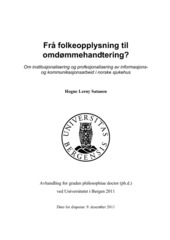| dc.description.abstract | This thesis focuses on information and communication practises in Norwegianhospitals in the wake of several reforms in the hospital sector. In particular, I studythe introduction of reputation and brand management (“omdømmehandtering”).Rethinking how to organize communication practises has been regarded as one oftoday’s most important organizational trends, and it is analysed as an important aspectof managing public sector organizations in Norway. However, the trend is not studiedin detail and we do not know the consequences of such organizational practices. Inthis thesis, I study the people who work with communication and information in thehospitals. I ask how the reputation management trend and theory inspires workpractises in hospitals and how (and whether) the information and communicationdepartments are rearranged in order to build reputation in hospitals.As an empirical starting point, I have chosen to study a certain group of people andtheir function in the hospitals. I argue that the information departments in thehospitals are at the forefront in implementing new communication practises and thatthis group will be a strategic case for studying reputation management. Through thestudy of the information departments, I shed light over the concrete and practicalwork that they do. This will gain insight in the organization of communication inhospitals and the embedding of new global ideas in an already establishedorganization.The theoretical perspective used and developed in the study has two maincomponents. Firstly, I argue that a pragmatic institutional perspective gives a naturalinterpretation framework for understanding the use of, spread and adaptation of ideas,trends and theories. My main argument is that institutional theories need to focus onhow ideas, trends and theories are embedded in local practices. Methodologically thestudy therefore focuses on the local and practical level of work. Secondly, I engage ina theoretical understanding of professions, which I use to analyse the practical day-todaywork of the information workers in the hospital. The point of departure in this perspective is not a traditional definition and model based profession-concept.However, it is an open, descriptive and sensitive perspective. The combination of apragmatic institutionalization perspective and a sensitive concept ofprofessionalization is the basis for studying institutionalization andprofessionalization of reputation management in hospitals.The data stems from three main sources. Firstly, I draw upon 27 semi-structuredinterviews with leaders of information departments in Norwegian hospitals. Secondly,I have conducted an observation-study of two different information departments. HereI followed daily activities, participated in meetings and had discussions with thepersonnel of the departments. A total of three weeks of observations were conducted.Thirdly, the study relies on 14 open in-depth interviews with information workers,mainly from the two departments where I did my field-study. In addition, thearguments in the thesis are based on documents from the hospitals (e.g. work plans,media reports, communication plans, magazines produced by hospitals) andparticipation in seminars and annual meetings in Informasjonsforum i Sykehus. Intotal, I have conducted 46 interviews with 41 different information workers and -leaders. The field-data consists of approximately 140 hours of observations. Althoughthe empirical data was collected in a relatively short period of time, I seek tounderstand the processes that the hospitals have undergone in the last decade, wherenew thinking on management, communication and reputation has been important.The different chapters of the thesis scrutinize various dimensions ofinstitutionalization and professionalization of information work and reputationmanagement. In chapter five, I analyze the development of perspectives and conceptsthat argue that an organizations’ communication is at the heart of the organizationsperformance. In addition to the mapping of the history of information work in Norway(chapter four), this establishes a context for the study. In chapter six, I present datadetailing the formal structure of information work in hospitals. In chapter seven, I usethe observation data in order to map out and understand the internal processes in the departments, and finally in chapter eight, the understandings and perspectives of theinformation workers are scrutinized in depth.The thesis provides insights to several aspects of information work and reputationmanagement in the Norwegian hospital sector. It documents the actual work, tasksand competence profiles of information departments in the hospitals. The field-dataalso reveal how information work is conducted in a daily and practical context.Finally, the study illustrates and discusses the actor’s viewpoints and discussions ofreputation management. The work practises in the information departments certainlyincorporates new communicational ideas: Techniques, repertoires and ideasassociated with reputation management theory are adopted by the hospitals. E.g., thedepartment is conducting reputation surveys; they help clinical divisions publish“positive” media stories; they train clinical personnel in media behaviours, etc. Still,this is not the full picture: The departments also engage in practical down-to-earthactivities like publishing, secretary work, photography etc. The information workersalso take an ambivalent position toward reputation management concepts andtheories. Although they engage in activities that imply defining their brand platforms,they see reputation management as something “suspect.” The practical context and themore specific institutional context of the hospital sector constrain and shape the wayin which reputation management is conceptualized and exercised. Hence, theories andconcepts from reputation management “flow” into the hospitals, but do not “stick” asColyvas and Jonssons (2011) argue. The thesis therefore gives fruitful nuances to theprogrammatic and optimistic literature on new communication practises.The study also shows a surprisingly heterogeneity in the work and workers. Amultitude of tasks, organizational structures and educational background exists in thefield under scrutiny. This points to a discrepancy with the reputation managementliterature. This literature promotes and advocates for a situation where a moreprofessional, homogenous and specialized group of workers engage in the effort ofbuilding, controlling and managing a hospital’s reputation. Hence, I finally explorethe possibilities that this situation reflects a Norwegian way of institutionalize work practices and concepts. This particular institutionalization underscores “strategicconformity” instead of “strategic communications.” | en_US |
